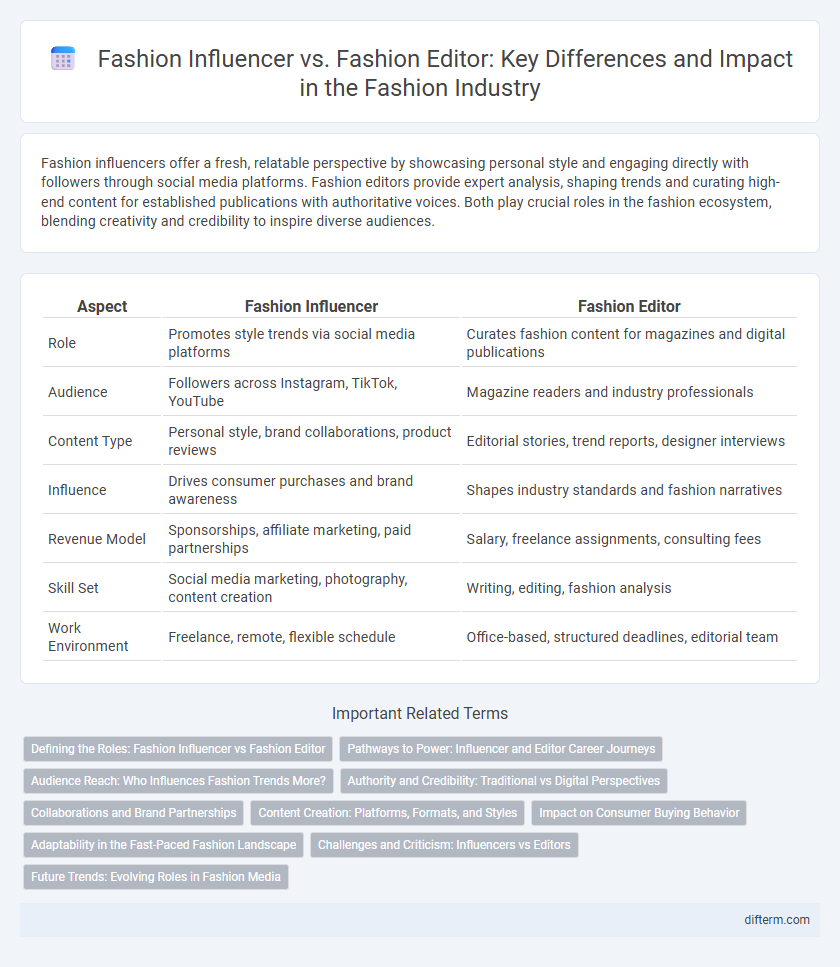Fashion influencers offer a fresh, relatable perspective by showcasing personal style and engaging directly with followers through social media platforms. Fashion editors provide expert analysis, shaping trends and curating high-end content for established publications with authoritative voices. Both play crucial roles in the fashion ecosystem, blending creativity and credibility to inspire diverse audiences.
Table of Comparison
| Aspect | Fashion Influencer | Fashion Editor |
|---|---|---|
| Role | Promotes style trends via social media platforms | Curates fashion content for magazines and digital publications |
| Audience | Followers across Instagram, TikTok, YouTube | Magazine readers and industry professionals |
| Content Type | Personal style, brand collaborations, product reviews | Editorial stories, trend reports, designer interviews |
| Influence | Drives consumer purchases and brand awareness | Shapes industry standards and fashion narratives |
| Revenue Model | Sponsorships, affiliate marketing, paid partnerships | Salary, freelance assignments, consulting fees |
| Skill Set | Social media marketing, photography, content creation | Writing, editing, fashion analysis |
| Work Environment | Freelance, remote, flexible schedule | Office-based, structured deadlines, editorial team |
Defining the Roles: Fashion Influencer vs Fashion Editor
Fashion influencers curate personal style content to engage and inspire followers on social media platforms, leveraging authenticity and relatability to drive trends and brand collaborations. Fashion editors, employed by magazines or media outlets, focus on shaping industry standards through editorial direction, trend forecasting, and overseeing photoshoots or fashion spreads. Both roles influence consumer behavior but differ in scope and authority, with editors often guiding brand narratives while influencers cultivate direct audience engagement.
Pathways to Power: Influencer and Editor Career Journeys
Fashion influencers leverage social media platforms like Instagram and TikTok to build personal brands and engage directly with millions of followers, often bypassing traditional industry gatekeepers. Fashion editors typically ascend through formal editorial roles at major fashion magazines, gaining authority via curated content, trend analysis, and industry relationships cultivated over years. Both career pathways intersect through content creation and trendsetting, yet diverge in influence scope--editors shape industry narratives from within, while influencers drive consumer trends through authentic, grassroots engagement.
Audience Reach: Who Influences Fashion Trends More?
Fashion influencers command extensive digital followings on platforms like Instagram and TikTok, engaging millions with real-time style updates and personal branding. Fashion editors, rooted in prestigious publications such as Vogue and Harper's Bazaar, shape industry standards through curated content and expert analysis that guides high fashion narratives. The immediate, interactive reach of influencers often sways mass market trends, while editors maintain lasting impact by endorsing emerging designers and setting editorial priorities.
Authority and Credibility: Traditional vs Digital Perspectives
Fashion editors hold long-established authority grounded in decades of editorial expertise and industry connections, shaping trends through reputable publications with stringent editorial standards. Fashion influencers leverage digital platforms to build credibility via direct audience engagement, authentic personal branding, and real-time content creation, often influencing consumer behavior through relatable storytelling. The shifting landscape balances traditional editorial authority with influencer-driven trust, reflecting evolving media consumption in the fashion industry.
Collaborations and Brand Partnerships
Fashion influencers forge authentic connections with audiences through social media, enabling dynamic brand partnerships that leverage personal style and engagement metrics for targeted marketing campaigns. Fashion editors utilize industry expertise and editorial authority to curate high-end collaborations, often shaping brand narratives in prestigious fashion publications. Both roles drive brand visibility, yet influencers emphasize direct consumer interaction while editors focus on editorial credibility and trendsetting.
Content Creation: Platforms, Formats, and Styles
Fashion influencers primarily create content on social media platforms such as Instagram, TikTok, and YouTube, utilizing short videos, reels, and Stories to engage followers with authentic, trend-driven styles. Fashion editors focus on long-form editorial content featured in magazines and online publications, emphasizing polished photography, detailed styling, and in-depth trend analysis. Influencers adopt a more spontaneous, personal approach, while editors maintain a curated, professional aesthetic tailored to brand campaigns and luxury fashion narratives.
Impact on Consumer Buying Behavior
Fashion influencers drive consumer buying behavior through authentic, relatable content and real-time social media engagement, fostering trust and immediate purchase decisions. In contrast, fashion editors shape consumer preferences by curating authoritative, trendsetting editorials that build long-term brand credibility and aspirational appeal. Both roles significantly impact fashion consumption patterns but operate through distinct channels and modes of influence.
Adaptability in the Fast-Paced Fashion Landscape
Fashion influencers exhibit high adaptability by quickly responding to emerging trends on social media platforms, leveraging real-time engagement to shape consumer preferences. Fashion editors rely on curated content and in-depth industry knowledge, adapting through strategic editorial planning and collaboration with designers to maintain authoritative voices amid rapid changes. Both roles demand agility, but influencers excel in immediacy while editors emphasize thoughtful trend interpretation within the evolving fashion landscape.
Challenges and Criticism: Influencers vs Editors
Fashion influencers face challenges such as maintaining authenticity while promoting brands, battling algorithm changes, and coping with intense social media scrutiny. Fashion editors encounter criticism for traditional gatekeeping, perceived lack of diversity, and slower adaptation to digital trends. Both roles struggle with balancing audience expectations and industry demands, highlighting the evolving dynamics in fashion media.
Future Trends: Evolving Roles in Fashion Media
Fashion influencers increasingly shape future trends through direct social media engagement and real-time feedback, bypassing traditional editorial gatekeeping. Fashion editors continue to provide authoritative analysis and curated content with a strategic, long-term vision rooted in industry expertise. The evolving roles reflect a hybrid landscape where digital influence and editorial credibility intersect, driving innovation in fashion media.
Fashion influencer vs fashion editor Infographic

 difterm.com
difterm.com